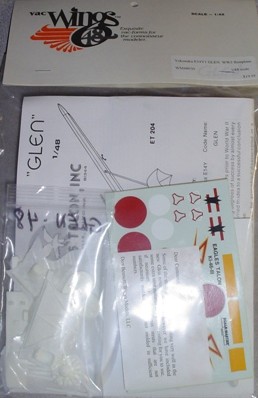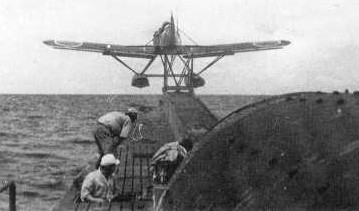
| KIT: | Wings 1/48 Yokosuka E14Y-1 'Glen' |
| KIT #: | WM 48030 |
| PRICE: | $19.95 |
| DECALS: | See Review |
| REVIEWER: | Rob Graham |
| NOTES: | Vacuformed with resin parts. |

| HISTORY |
In 1937, the Imperial Japanese Navy issued a requirement for a small
submarine-based reconnaissance aircraft. In complete secrecy, Mitsuo Yamada
of the 1st Naval Air Technical Arsenal designed what would eventually go
down in history as the only aircraft to bomb the U.S. mainland. The Type 0
Small Naval Reconnaissance Seaplane Model 11 (Allied Code Name: Glen) made
its wartime debut performing post-attack recon work on 17-December-1941,
allowing assessment of the attack on Pearl Harbor.

With 125 aircraft being built by Watanabe Tekkosho between 1941 and '43, the aircraft was a single-engine, two-seat, twin-float reconnaissance seaplane; the fuselage was made of welded steel tubing, covered with fabric, wood, and light alloy metal. The wings were light metal alloy spars and wooden ribs, with wood-covered leading edges, all covered with doped fabric. The aircraft weighed 2,469 lbs empty, 3,197 loaded, and was powered by a Hitachi Tempu 12 9-Cylinder radial engine rated at 340 HP for take-off, and drove a wooden two-bladed propeller. Armed with a flexible, rear-firing, Type 92 7.7mm machine gun, the Glen was also capable of carrying 132 lbs. of bombs on its two underwing pylons. Maximum speed was 133Kt, cruising speed was 90Kt, and range was 476 nautical miles.
It's hard for many people to imagine an aircraft with such humble specifications as the only aircraft to have bombed America's mainland (albeit superficially), but the mission for which it was designed, as a submarine-launched reconnaissance plane, was a considerable part of what made its accomplishments possible; it was really an extension of the IJN's submarine force. Note, too, that its construction seemed to have been quite stealthy, as it was able to conduct much of its business without being detected by radar. I won't really elaborate on Nobuo Fujita's September of 1942 attacks from the IJN submarine I-25 on Oregon, since these are probably the best documented facts about this otherwise rather obscure aircraft.
| THE KIT |
 This
kit is a vacuum-formed model, and seems to be the only 1/48 Yokosuka E14Y
kit marketed.
This
kit is a vacuum-formed model, and seems to be the only 1/48 Yokosuka E14Y
kit marketed.
The kit consists of the following:
 The
resin parts are decent, with no obvious flaws or excessive flash. I have
noticed the resin parts are reasonably accurate, and I will use them,
though I will likely use SOME parts as guides for scratchbuilding efforts.
The
resin parts are decent, with no obvious flaws or excessive flash. I have
noticed the resin parts are reasonably accurate, and I will use them,
though I will likely use SOME parts as guides for scratchbuilding efforts.
The plastic is about .030" or so thick, has some heft to it, and will likely work well. There are a few little pits in the molds here and there, but it's all pretty tolerable if you're considering building a vac kit in the first place. The overall shape looks good, although I haven't laid the parts down to see how they compare for shape to Nohara's artwork in Model Art 565. The panel lines are recessed, but there is no "tenting" on the fuselage or wing surfaces to simulate fabric areas; this shouldn't really be a huge problem, as photos show this effect was pretty subtle on the real aircraft.
Instructions are exploded views. While they're clear and will be useful, I see a definite need to have more reference material prior to adding details to or building this model. The interior of the actual aircraft was made of a welded steel structure, and the shape of this structure is detailed in Model Art 565; this detail would be a significant addition and foundation for any interior detailing effort. Also, the Mushroom Publications book shows a cockpit drawing on page 39 which is actually a picture of an Aichi M6A1 - so don't be fooled into making a control panel that is entirely too large; the control panel was actually quite simple and small (turn the page to 40 of the same publication, and you'll see an image of the Glen's control panel). I can't really comment on the seats or floorboard, as these items aren't detailed well enough in any of my publications, although page 206 of the Model Art book does show a profile drawing of the seats; the kit's seats actually look like they will be quite helpful. I have a few references on this aircraft which I consider indispensable, although I would like to perform more research to nail down more details before I dive in to build a model of this aircraft:
As I can best ascertain, the details of this aircraft may be fleshed out using a kitbashed Lewis-type machine gun as seen in many Japanese naval aircraft, some bomb racks from an A6M2-N Rufe floatplane fighter, and various radio communications gear as may be found in the D3A1 Val dive bomber, but I can't really say much about the layout of these items. I think the best way to build the interior steel tubing structure would be to solder some copper 1/64" thick wire (18 to 20 gauge or .030" to .040" or 0.75mm to 1.0mm would probably work nicely for much of it) or something else similar in size (plastic rod or other material).
The decals provided are actually from the Eagles' Talon Mitsubishi Ki-46 "Dinah" kit and appear to be suitably sized for the Glen, although there are no other markings that would be useful for a Glen besides the Hinomarus. Finding tail codes and other markings should not be too difficult, as they were pretty much standard IJN fare, and there was no form of elaborate unit insignia. Interior colors are probably best applied as predominantly FS-34082, about like Mitsubishi Interior Green.
| CONCLUSIONS |
My thoughts are that it looks like a very nice vac kit, and although vac kits are not everyone's cup of tea, this one looks buildable. I have bought the Engines 'n' Things resin Hitachi engine for it, see that as a better option than the kit's engine - though that's just my opinion; another option, if I recall, would be to use the engine/prop from the Otaki Willow kit. I foresee a good amount of work to get this kit done, but look forward to the challenge someday. Don sent a booklet on how to build vac kits, and I think it's actually possible to make a very respectable model with this vac kit.
The complete Wings line (48th and 72d scales) is available from Don's Model Works.
Preview copy purchased from Don's Modelworks directly, and I THOROUGHLY enjoyed doing business with him - I would GLADLY recommend him for speedy service and amazingly personal care in customer service.
January 2006
If you would like your product reviewed fairly and quickly by a site that has over 300,000 visitors a month, please contact me or see other details in the Note to Contributors.